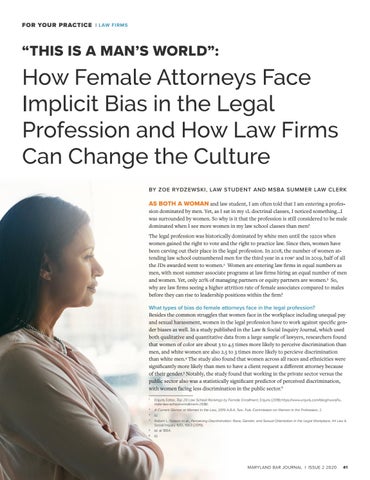FOR YOUR PRACTICE
| LAW FIRMS
“THIS IS A MAN’S WORLD”:
How Female Attorneys Face Implicit Bias in the Legal Profession and How Law Firms Can Change the Culture BY ZOE RYDZEWSKI, LAW STUDENT AND MSBA SUMMER LAW CLERK
AS BOTH A WOMAN and law student, I am often told that I am entering a profes-
sion dominated by men. Yet, as I sat in my 1L doctrinal classes, I noticed something...I was surrounded by women. So why is it that the profession is still considered to be male dominated when I see more women in my law school classes than men? The legal profession was historically dominated by white men until the 1920s when women gained the right to vote and the right to practice law. Since then, women have been carving out their place in the legal profession. In 2018, the number of women attending law school outnumbered men for the third year in a row1 and in 2019, half of all the JDs awarded went to women.2 Women are entering law firms in equal numbers as men, with most summer associate programs at law firms hiring an equal number of men and women. Yet, only 20% of managing partners or equity partners are women.3 So, why are law firms seeing a higher attrition rate of female associates compared to males before they can rise to leadership positions within the firm? What types of bias do female attorneys face in the legal profession? Besides the common struggles that women face in the workplace including unequal pay and sexual harassment, women in the legal profession have to work against specific gender biases as well. In a study published in the Law & Social Inquiry Journal, which used both qualitative and quantitative data from a large sample of lawyers, researchers found that women of color are about 3 to 4.5 times more likely to perceive discrimination than men, and white women are also 2.5 to 3 times more likely to percieve discrimination than white men.4 The study also found that women across all races and ethnicities were significantly more likely than men to have a client request a different attorney because of their gender.5 Notably, the study found that working in the private sector versus the public sector also was a statistically significant predictor of perceived discrimination, with women facing less discrimination in the public sector.6 1
4 2 3
5
6
Enjuris Editor, Top 20 Law School Rankings by Female Enrollment, Enjuris (2018) https://www.enjuris.com/blog/news/fe�male-law-school-enrollment-2018/. A Current Glance at Women in the Law, 2019 A.B.A. Sec. Pub. Commission on Women in the Profession, 2. Id. Robert L. Nelson et al., Perceiving Discrimination: Race, Gender, and Sexual Orientation in the Legal Workplace, 44 Law & Social Inquiry 1051, 1063 (2019). Id. at 1064. Id.
MARYLAND BAR JOURNAL | ISSUE 2 2020
41


















